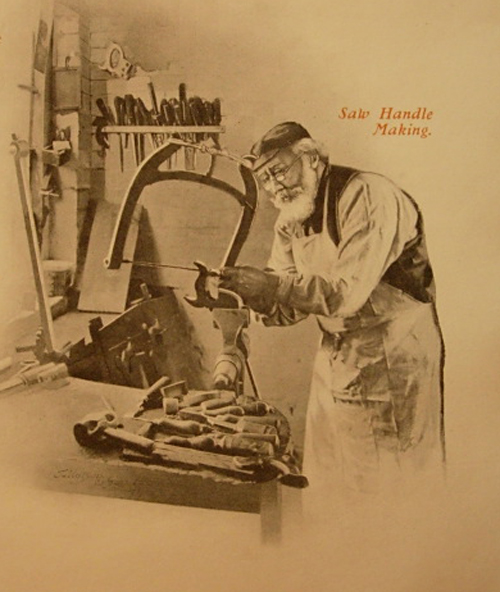|
|
|
 Joel's Blog Joel's Blog |
 Built-It Blog Built-It Blog |
 Video Roundup Video Roundup |
 Classes & Events Classes & Events |
 Work Magazine Work Magazine |
| Newer Entries... | |
 | The New Phone System is Here!! The New Phone System is Here!! - 11/04/2008 |
 | Awl or None - 10/05/2008 |
 | The Cloisters - 10/01/2008 |
 | Chosera stones have arrived! - 09/06/2008 |
 | Why I Collect Books - or at least one reason why - 08/17/2008 |
 | We're going to Kentucky, we're going to the fair... - 08/08/2008 |
 | Goodbye Lily White Washita - We hardly knew you - 07/31/2008 |
 | Thing 1 and 2 Fish - 07/10/2008 |
 | Sticker Shock - 07/03/2008 |
 | Saw Handle Making In Sheffield - 06/27/2008 |
 | It Ain't Fine Woodworking But It Needed To Be Done - 06/18/2008 |
 | L'Art du Menuisier ( The Art of the Carpenter) by Andre Roubo - 06/07/2008 |
 | Iron - 05/19/2008 |
 | Primary Sources - 05/06/2008 |
 | The Lockwood De Forest Residence 7 E. 10th Street NYC - 04/19/2008 |
 | How to Grind - 04/06/2008 |
 | Carving a Tudor Rose - 03/23/2008 |
 | Naniwa Superstones and a Tip for Flattening Waterstones Less Often - 03/17/2008 |
 | Shipping - 03/08/2008 |
 | Books on Business - 02/25/2008 |
| Older Entries... | |
|
Hours: M-F 9:00-5:00, closed Sat,Sun Our Guarantee & Return Policy Shipping and Sales Tax Info Privacy Policy Holiday Calendar |
|
Contact Us:
Email: support@toolsforworkingwood.com Phone: 800-426-4613 or 718-499-5877 Visit Us in Brooklyn: Directions to Our Showroom © 1999-2019 toolsforworkingwood.com Powered by 01 Inc. Coded entirely in NYC |



 The flurry of activity cause by all the premium saw-making going on in the US right now has prompted a lot of talk about the "boutique" saw maker of today contrasting with the mass-produced saws of yesteryear. In the US, companies like Disston did use a lot of fancy production equipment in a big factory, but in England, at least in 19th century Sheffield, Almost all production, even in large factories, was done by individuals paid by piecework. So even if a famous name was stamped on the label chances are the tool was made by a subcontractor either working on the premises of a large company or in a small shop subcontracting to some large company. These small makers were known as "little mesters" or "little masters" and they formed the core of Sheffield manufacture. Saw making was no different than anything else and the saw makers were little mesters, hand-making thousands of productions saws in a decidedly "boutiquey" sort of way.
The flurry of activity cause by all the premium saw-making going on in the US right now has prompted a lot of talk about the "boutique" saw maker of today contrasting with the mass-produced saws of yesteryear. In the US, companies like Disston did use a lot of fancy production equipment in a big factory, but in England, at least in 19th century Sheffield, Almost all production, even in large factories, was done by individuals paid by piecework. So even if a famous name was stamped on the label chances are the tool was made by a subcontractor either working on the premises of a large company or in a small shop subcontracting to some large company. These small makers were known as "little mesters" or "little masters" and they formed the core of Sheffield manufacture. Saw making was no different than anything else and the saw makers were little mesters, hand-making thousands of productions saws in a decidedly "boutiquey" sort of way.
Cheers, great to see the old material in your blog.
I sadly don't have a copy of the "Tyzack Centenary Souvenir, 1912"
thanks,
joel
A real treat to see this. I have a list of Sheffield saw handle makers, if you are ever interested. Some were in business over several generations.
Great Blog
Ray Gardiner
Hawley Collection ( I declare an interest, as one who has frequently used the
collection's material, and more importantly, Ken Hawley's brains, in
research). But please correct your spelling of Sheffield's Little MESTERS, not
the germanicised version you perpetrated!! Mester is simply the local way of
saying Mister or master.
The illustration may not have been a little mester, who would have worked
alone or perhaps with an apprentice or a time-served journeyman, but one of
the employees of Thomas Turner. Other illustrations in the book show Turner
employees engaged in other of the processes of sawmaking. Only the larger
firms, of which TT was one, would have had an in-house handle maker. And
because Sheffield was "one great workshop" TT would undoubtedly have at
times bought in handles (from little mesters or other firms) if they had orders
that were too big or too pressing for their own people to complete on time.
One of the processes in handle-making that is seldom mentioned was the
practice of rubbing the wood down very hard with a bone (usually a rib bone,
as it was fairly flat) to close the grain; only on the better quality handles. the
Hawley collection has examples of these bones.